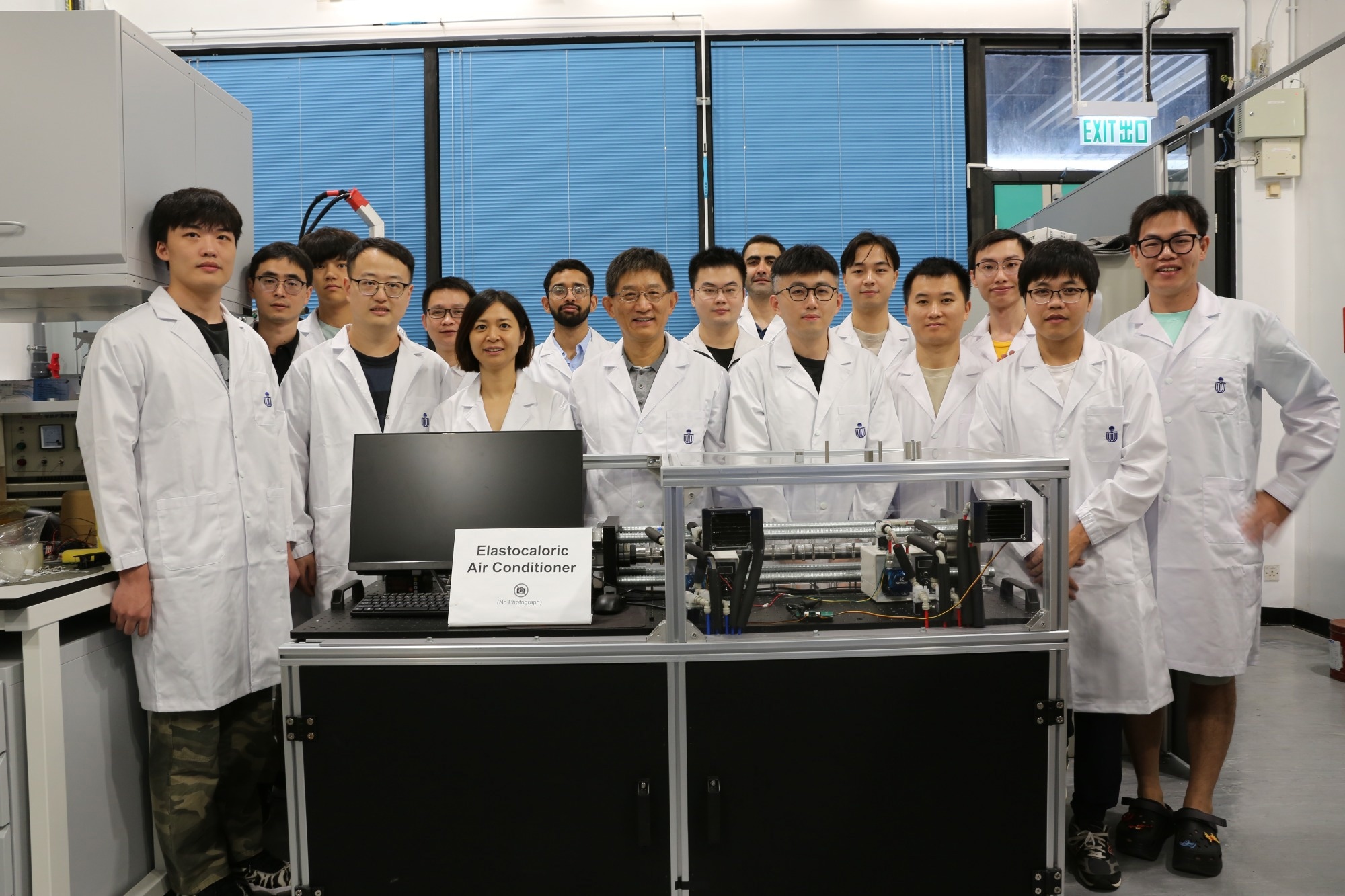Researchers at the Hong Kong University of Science and Technology have created an environmentally friendly refrigeration system that breaks world records for cooling performance. This innovation has the potential to revolutionize businesses that depend on cooling while lowering global energy consumption. The journal Nature Energy published this research.
 Prof. SUN Qingping (front row, fourth left), Prof. YAO Shuhuai (front row, third left), both Professors of Department of Mechanical and Aerospace Engineering (MAE), MAE Postdoctoral Research Associate Dr. ZHOU Guoan (front row, second left), MAE Ph.D. student LI Zexi (front row, first left), and other members of the research team with their elastocaloric air conditioner. Image Credit: The Hong Kong University of Science and Technology
Prof. SUN Qingping (front row, fourth left), Prof. YAO Shuhuai (front row, third left), both Professors of Department of Mechanical and Aerospace Engineering (MAE), MAE Postdoctoral Research Associate Dr. ZHOU Guoan (front row, second left), MAE Ph.D. student LI Zexi (front row, first left), and other members of the research team with their elastocaloric air conditioner. Image Credit: The Hong Kong University of Science and Technology
The novel electrocaloric cooling technology offers a viable path for expediting the commercialization of this disruptive technology and resolving the environmental issues related to conventional cooling systems. It offers an efficiency improvement of over 48 %.
Conventional vapor compression refrigeration technologies rely on high global warming potential refrigerants. In contrast, solid-state elastocaloric refrigeration, which utilizes Shape Memory Alloy (SMA) refrigerants, offers an environmentally friendly alternative. These SMA refrigerants are greenhouse gas-free, 100 % recyclable, and energy-efficient, operating based on the latent heat generated during the cyclic phase transition of SMAs.
However, the commercialization of this developing technology has been hampered by the relatively limited temperature rise between 20 and 50 K, which is a significant performance indication of the cooling device's ability to transfer heat from a low-temperature source to a high-temperature sink.
To address the challenge, a research team led by Prof. Qingping Sun and Prof. Shuhuai Yao from the Department of Mechanical and Aerospace Engineering developed a multi-material cascading elastocaloric cooling device using nickel-titanium (NiTi) shape memory alloys, setting a new world record in cooling performance.
The researchers selected three NiTi alloys to operate at different temperature zones: the cold end, middle end, and hot end, each with varying phase transition temperatures. By ensuring that each NiTi unit functioned within its optimal temperature range, they significantly enhanced the cooling efficiency. This approach extended the device's superelastic temperature window to over 100 K by aligning the working temperatures of each unit with their respective phase transition temperatures.
The multi-material cascade elastocaloric cooling mechanism they developed achieved a temperature rise of 75 K on the waterside, surpassing the previous world record of 50.6 K.
Building on their success in developing elastocaloric cooling materials and architectures, which have led to numerous patents and publications in prestigious journals, the research team plans to continue advancing high-performance shape memory alloys and devices for both high-temperature heat pumping and sub-zero elastocaloric cooling applications.
Their goal is to further refine material characteristics and create highly energy-efficient refrigeration systems, with the aim of commercializing this innovative technology. Given that approximately 20 % of the world's electricity is currently used for space heating and cooling, and with projections indicating that space cooling will account for the second-largest share of global electricity demand by 2050, this technology could have a significant impact on future energy use.
In the future, with the continuous advancement of materials science and mechanical engineering, we are confident that elastocaloric refrigeration can provide next-generation green and energy-efficient cooling and heating solutions to feed the huge worldwide refrigeration market, addressing the urgent task of decarbonization and global warming mitigation.
Qingping Sun, Professor, Department of Mechanical and Aerospace Engineering, Hong Kong University of Science and Technology
The study was conducted by Professor Sun and Yao (both Corresponding authors), Postdoctoral Research Associate and Ph.D. Graduate Dr. Guoan Zhou as the First Author, Ph.D. Student Zexi LI, Ph.D. Graduates Yuxiang Zhu and Peng Hua, as well as collaborators from Wuhan University.
Journal Reference:
Zhou, G., et al. (2024) A multi-material cascade elastocaloric cooling device for large temperature lift. Nature Energy. doi.org/10.1038/s41560-024-01537-3.